Wondering what web analytics is? Still, confused about what it does and how it helps you set up the ideal strategy for your website? Well, do you think pageviews, unique pageviews, new visitors, and returning visitors are all identical? If yes, then you’re wrong there buddy.
Web analytics is a wide topic, so without further ado, let’s get ahead and discuss!
In this article, you will learn A to Z of web analytics, from what it is to why you should use it and how to use it!
Table of Contents
- What is Web Analytics?
- Why use Web Analytics?
- Importance of Web Analytics for Tracking Website Performance!
- What are the main pillars of web analytics?
- What are the Different Types of Analytical Tools?
- What are the Key Metrics of Web Analytics?
- 5 Best Web Analytics Tools For Your Business
- What are the common issues with web analytics?
- Wrapping Up!
What is Web Analytics?
Web analytics is the process of measuring, collecting, analyzing, and reporting data related to a website’s traffic and usage patterns.
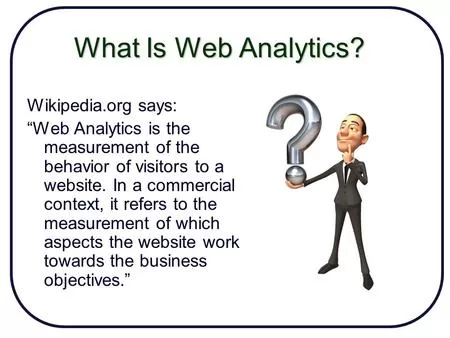
It helps website owners understand how users interact with their websites. How? By analyzing the data of several visitors, the pages they visit, how long they stay, and how they found the site.
The goal of web analytics is to optimize a website for better performance, and user experience, and to inform business decisions based on data-driven insights. And it focuses on improving user experience by identifying measures based on your organization’s goals using website data.
Now, let’s understand why you should web analytics.
Why use Web Analytics?

Improving the website is the primary goal of every website owner or digital marketer. Hence, you need to know about its use. Web analytics is used for a variety of purposes, which includes:
1. Understanding user behavior:
Web analytics can provide insight into how users interact with a website, including which pages they visit, how long they stay, and where they come from!
2. Improving website performance:
By analyzing website data, website owners can identify areas for improvement, such as slow-loading pages or areas where users are dropping off.
3. Measuring the success of marketing campaigns:
Web analytics can track the success of different marketing campaigns, such as email campaigns or social media promotions, and determine their return on investment (ROI).
4. Informing business decisions:
Web analytics data can be used to inform critical business decisions, such as which products to feature on a website, which content to produce, or which geographic areas to target with marketing efforts.
5. Optimizing the user experience:
By understanding user behavior and the performance of different pages, website owners can make changes to improve the overall user experience.
Importance of Web Analytics for Tracking Website Performance!
Running a website is no easy task, you have to consider a lot of factors and constantly track its performance. Hence, in this section, we will be learning why web analytics is important!
1. Continual Monitoring:
Continual monitoring of web analytics data allows you to track and identify trends and patterns in user behavior over time. This helps you understand how your audience is evolving and what changes to your website.
It can also guide you with marketing campaigns that be necessary to keep pace with those changes. With regular monitoring, you can quickly respond to any issues or opportunities that arise, ensuring that your website remains optimized for maximum results.
2. Budget Optimisation:
Web analytics can help you optimize budget allocation and improve the return on investment (ROI) of your marketing campaigns.
This includes identifying the campaigns that are generating the most traffic, conversions, and revenue, and making adjustments to your budget to maximize the impact of your marketing efforts.
3. Funnel Tracking:
Funnel tracking refers to the process of tracking user behavior as they progress through various stages of the customer journey, from awareness to conversion. Using web analytics, you can identify roadblocks that prevent users from completing desired actions (such as a purchase).
With this information, you can make changes to your website and marketing campaigns to improve the user experience and increase conversions.
Overall, web analytics is an essential tool for businesses to understand their online presence and make informed decisions to drive growth and success.
What are the main pillars of web analytics?
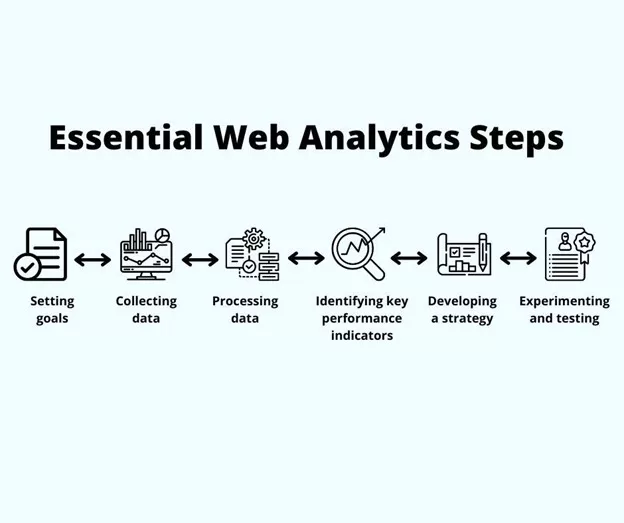
When working with web analytics, you must know about its pillars first. Why? Pillars are the foundation that makes building strong! So, to understand a website’s analytics better and make an informed decision, pay attention to these four pillars:
Data Collection:
It helps in collecting data from various sources like website traffic, social media, and advertising platforms. It also stores it in a central location for analysis.
This data can be collected through a variety of methods, including web analytics software, tracking pixels, and APIs.
For example, Google Analytics is a commonly used tool for collecting website traffic data.
Data Processing:
Here it cleans and transforms raw data into a format that can be analyzed and used to gain insights. This step includes data tasks such as filtering out irrelevant data, transforming it into a standardized format, and combining from multiple sources.
For example, data collected from different marketing campaigns can be combined to get a complete picture of overall marketing performance.
Data Analysis:
This involves using statistical techniques and algorithms to identify patterns, trends, and relationships in the data, and to draw meaningful conclusions.
This step includes identifying top-performing pages, calculating conversion rates, and analyzing user behavior.
For example, data analysis may reveal that a high percentage of users are leaving a website after viewing only one page, indicating a need to improve the overall user experience.
Reporting:
The final pillar is reporting. It helps in presenting the data and insights generated in a clear and actionable format like charts, graphs, and dashboards.
Its goal is to communicate the insights generated from the analysis to decision-makers, such as business owners, marketing teams, and product teams, so they can make informed decisions.
For example, a report may show that a particular marketing campaign resulted in a high number of conversions. It indicates that similar campaigns should be run in the future.
These four pillars work together to provide a comprehensive understanding of website performance and user behavior. And these will lead to making effective business decisions and drive growth and success. With this, let’s move ahead toward different types of analytics tools!
What are the Different Types of Analytical Tools?
These web analytical tools help you in understanding the website metrics and take realistic decisions for the growth of your website. There are six types of analytical tools, they are as follows:
1. Web analytics platforms:
These tools track and analyze website traffic, including sources of traffic, visitor behavior, and conversion rates.
Tools Like: Google Analytics, Adobe Analytics, and Piwik/Matomo.
2. Marketing automation tools:
These marketing automation tools automate and optimize marketing processes, including email marketing, lead generation, and customer segmentation.
Tools Like: Marketo, Pardot, and Hubspot.
3. Social media analytics tools:
These tools track and analyze social media data, including engagement, reach, and sentiment.
Tools Like: Hootsuite Insights, Brandwatch, and Sprout Social.
4. Data visualization and dashboarding tools:
These tools help to display data and insights in a visually appealing and easy-to-understand format.
Tools Like: Tableau, Looker, and Power BI.
5. Customer relationship management (CRM) tools:
CRM software or tools help to manage customer interactions and data, including lead tracking, sales forecasting, and customer segmentation.
Tools Like: Salesforce, Hubspot CRM, and Zoho CRM.
6. Heat mapping tools:
These tools help to visualize how users interact with a website, including clicks, scrolls, and mouse movements.
Tools Like: Hotjar, Mouseflow, and Crazy Egg.
Which tool to select will depend solely on the company and its requirement. If you are an eCommerce website selling services, you will need a tool that can help you track your sales as well. However, if you are a knowledge provider, you might want to skip a CRM tool!
What are the Key Metrics of Web Analytics?
There are several key metrics of web analytics. Every tool will have different metrics you can measure. However, here are some common metrics you need to measure to track your website’s performance:
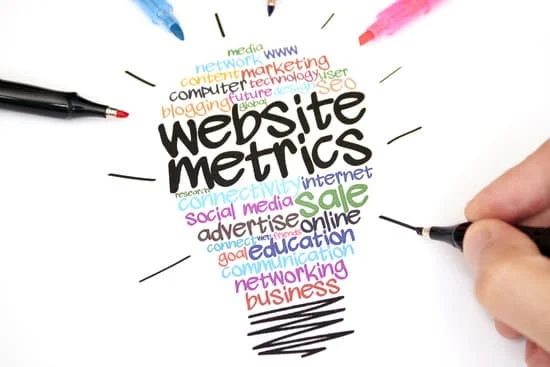
1. Traffic:
This includes metrics such as unique visitors, page views, and bounce rate, which provide insights into the overall volume of traffic to your website and how users are engaging with your content.
2. Acquisition:
This includes metrics such as referral sources, organic search, and paid search, which provide insights into where your traffic is coming from and how well your marketing campaigns are performing.
3. Behavior:
Another web analytic metric is behavior. It metric provides insights that tell, how users are interacting with your websites, which pages they are visiting, and where they drop off. It tracks users’ average time on site, pages per session, and exit rate.
4. Conversion:
This includes metrics such as conversion rate, revenue, and goal completions. As a result, it provides insights into your website’s performance in terms of achieving its objectives, like generating leads or sales.
5. E-commerce:
If your website includes an online store, you will want to track metrics such as average order value, cart abandonment rate, and product performance. This will provide insights into how well your e-commerce operations are performing.
6. Mobile:
With the growing use of mobile devices, it’s important to track mobile traffic, mobile conversion, and mobile bounce rate. This will help you in learning insights about the website’s performance on mobile devices.
All the above-mentioned metrics provide valuable insights to understand websites and your marketing campaigns’ performance. With that data, you can make important decisions regarding the website and marketing strategy to get the optimum output!
5 Best Web Analytics Tools For Your Business
There are many web analytics tools available. However, selecting the best one for you depends on your requirements, needs, and budget. Let’s have a look at the five best web analytics tools for businesses:
1. Google Analytics:
It is a free and widely used tool that provides a comprehensive suite of web analytics features. In addition to that, it shows various data from real-time and visitor segmentation to conversion tracking and more.

To get a complete and clear picture of your website’s performance, integrate it with Google AdWords and Search Console.
2. Adobe Analytics:
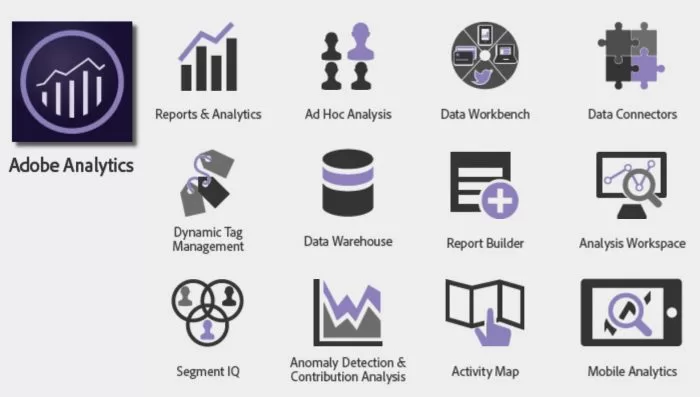
Adobe Analytics is a paid tool that provides advanced analytics capabilities, including cross-device tracking, data analysis, and reporting. You can also integrate it with other Adobe products, like Adobe Marketing Cloud, to get a holistic view of customer behavior.
3. Piwik/Matomo:
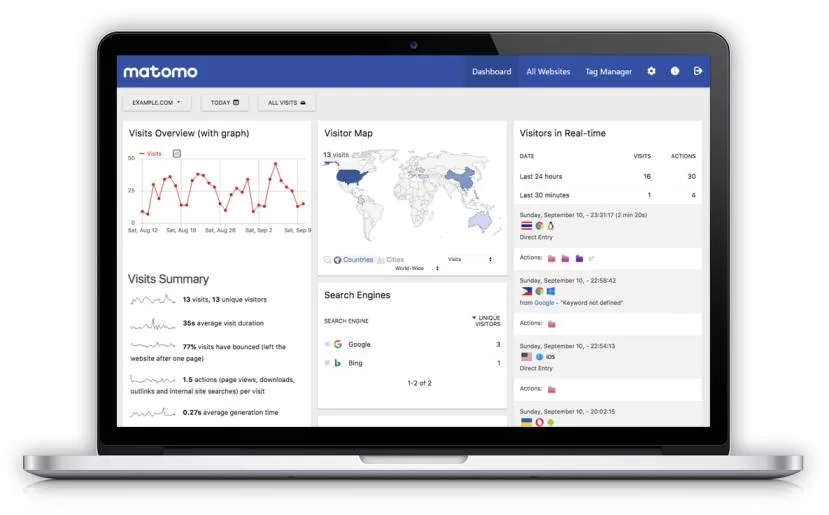
This is an open-source web analytics platform that provides many of the same features as Google Analytics like real-time data, visitor segmentation, etc.
Piwik has one advantage, you can host it on your own servers, which will give you more privacy and security control.
4. Mixpanel:
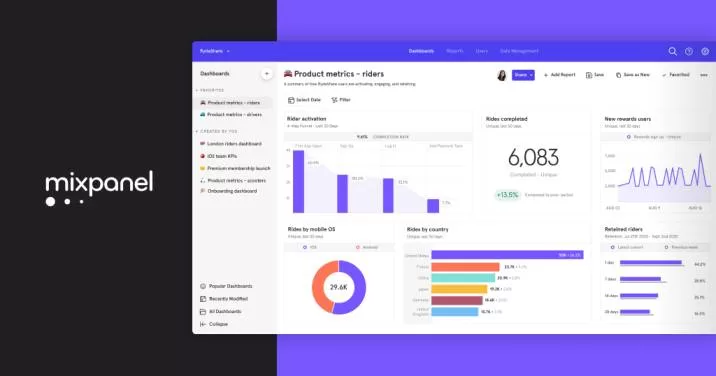
Mixpanel provides advanced analytics features like event tracking, and funnel analysis, along with real-time data. This web analytics tool is designed for mobile and web applications with a user-friendly interface for data analysis.
5. Clicky:
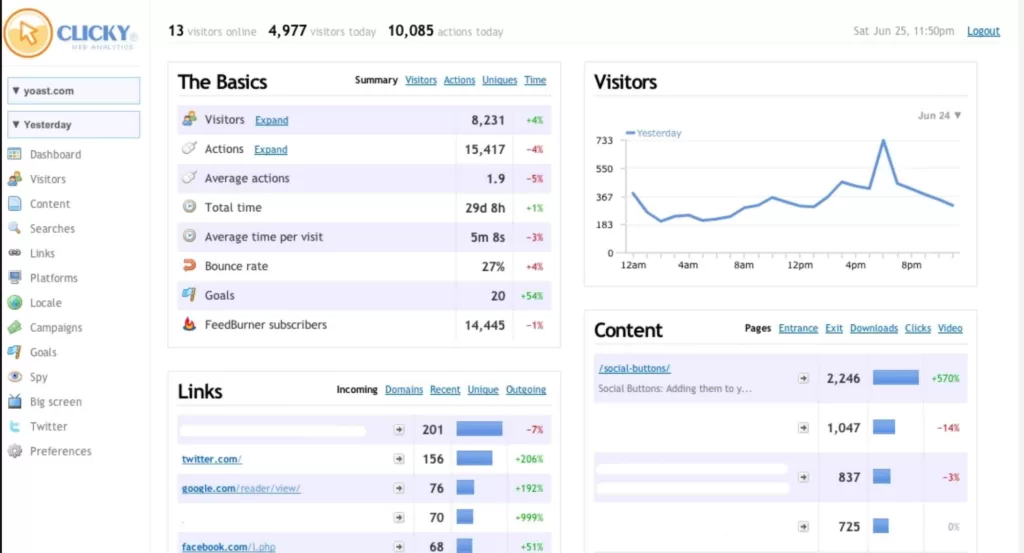
Clicky is yet another paid tool that provides real-time analytics, including visitor segmentation, conversion tracking, and heat maps. It is known for its clean and user-friendly interface.
What are the common issues with web analytics?
Addressing issues is necessary! And for that knowing them is critical. Who said web analytics doesn’t have or create issues in your marketing plan? There are several common issues with web analytics that you must understand. They are as follows:
– Data Quality
Incorrect or inconsistent data can lead to inaccurate insights and poor decision-making. This can be a result of a variety of factors like tracking code errors, incorrect data collection, or inconsistent data reporting.
– Data Privacy
Privacy concerns can arise with the collection and use of user data, especially if sensitive information is being tracked. It’s important to ensure that data privacy policies are in place and that data is collected and used responsibly and ethically.
– Data Sampling
It’s not always possible to track all data due to high traffic on the website. Data sampling can be used to overcome this issue, but it can also introduce biases and inaccuracies.
– Data Overload
A website has a bunch of information available which makes it difficult to identify the important metric. And this can lead to data overload and make it challenging to focus on the most impactful insights.
– Technical Challenges
Technical issues like server downtime or tracking code errors can impact the accuracy and reliability of data. It’s important to have a plan in place to address these issues and ensure that data is being collected and reported accurately.
– Integration with Other Tools
Integrating web analytics with other tools, such as marketing automation software or CRM systems, can be complex and challenging. It’s important to have a clear understanding of the capabilities and limitations of these tools and how they can be integrated to provide a comprehensive view of data.
By addressing these common issues, you can ensure that your web analytics efforts provide accurate and actionable insights. Furthermore, it is also helping you to optimize your website and marketing campaigns for maximum results.
Wrapping Up!
Web analytics is important to track your website’s performance as well as to ideate marketing strategy. Hence, you need to know everything about it. In this article, you read what web analytics is, its importance, key metrics, pillars, and even common issues you might face. In addition to that, we also helped you with the 5 best web analytics tools you can use!
